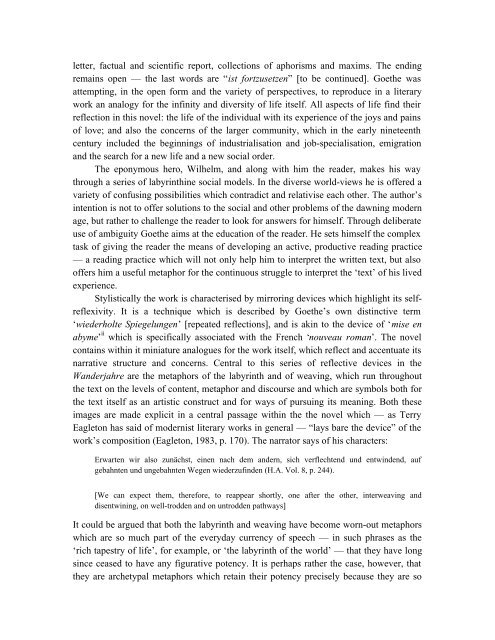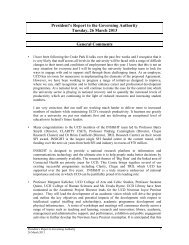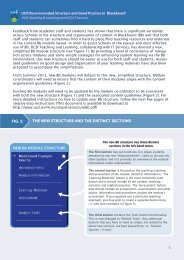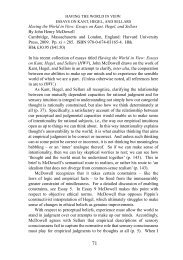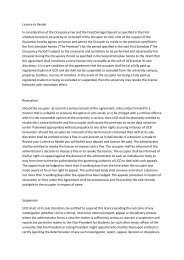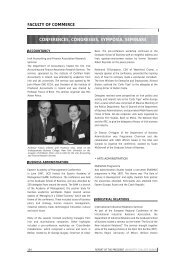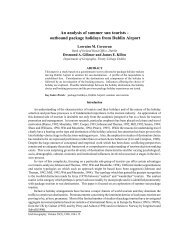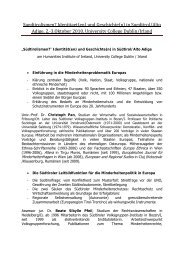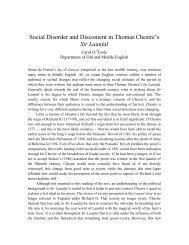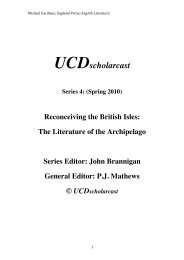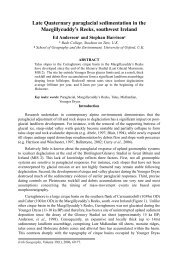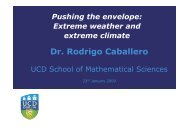Weaving the labyrinth of the text — the novel poetics of Goethe's ...
Weaving the labyrinth of the text — the novel poetics of Goethe's ...
Weaving the labyrinth of the text — the novel poetics of Goethe's ...
You also want an ePaper? Increase the reach of your titles
YUMPU automatically turns print PDFs into web optimized ePapers that Google loves.
letter, factual and scientific report, collections <strong>of</strong> aphorisms and maxims. The ending<br />
remains open <strong>—</strong> <strong>the</strong> last words are “ist fortzusetzen” [to be continued]. Goe<strong>the</strong> was<br />
attempting, in <strong>the</strong> open form and <strong>the</strong> variety <strong>of</strong> perspectives, to reproduce in a literary<br />
work an analogy for <strong>the</strong> infinity and diversity <strong>of</strong> life itself. All aspects <strong>of</strong> life find <strong>the</strong>ir<br />
reflection in this <strong>novel</strong>: <strong>the</strong> life <strong>of</strong> <strong>the</strong> individual with its experience <strong>of</strong> <strong>the</strong> joys and pains<br />
<strong>of</strong> love; and also <strong>the</strong> concerns <strong>of</strong> <strong>the</strong> larger community, which in <strong>the</strong> early nineteenth<br />
century included <strong>the</strong> beginnings <strong>of</strong> industrialisation and job-specialisation, emigration<br />
and <strong>the</strong> search for a new life and a new social order.<br />
The eponymous hero, Wilhelm, and along with him <strong>the</strong> reader, makes his way<br />
through a series <strong>of</strong> <strong>labyrinth</strong>ine social models. In <strong>the</strong> diverse world-views he is <strong>of</strong>fered a<br />
variety <strong>of</strong> confusing possibilities which contradict and relativise each o<strong>the</strong>r. The author’s<br />
intention is not to <strong>of</strong>fer solutions to <strong>the</strong> social and o<strong>the</strong>r problems <strong>of</strong> <strong>the</strong> dawning modern<br />
age, but ra<strong>the</strong>r to challenge <strong>the</strong> reader to look for answers for himself. Through deliberate<br />
use <strong>of</strong> ambiguity Goe<strong>the</strong> aims at <strong>the</strong> education <strong>of</strong> <strong>the</strong> reader. He sets himself <strong>the</strong> complex<br />
task <strong>of</strong> giving <strong>the</strong> reader <strong>the</strong> means <strong>of</strong> developing an active, productive reading practice<br />
<strong>—</strong> a reading practice which will not only help him to interpret <strong>the</strong> written <strong>text</strong>, but also<br />
<strong>of</strong>fers him a useful metaphor for <strong>the</strong> continuous struggle to interpret <strong>the</strong> ‘<strong>text</strong>’ <strong>of</strong> his lived<br />
experience.<br />
Stylistically <strong>the</strong> work is characterised by mirroring devices which highlight its selfreflexivity.<br />
It is a technique which is described by Goe<strong>the</strong>’s own distinctive term<br />
‘wiederholte Spiegelungen’ [repeated reflections], and is akin to <strong>the</strong> device <strong>of</strong> ‘mise en<br />
abyme’ ii which is specifically associated with <strong>the</strong> French ‘nouveau roman’. The <strong>novel</strong><br />
contains within it miniature analogues for <strong>the</strong> work itself, which reflect and accentuate its<br />
narrative structure and concerns. Central to this series <strong>of</strong> reflective devices in <strong>the</strong><br />
Wanderjahre are <strong>the</strong> metaphors <strong>of</strong> <strong>the</strong> <strong>labyrinth</strong> and <strong>of</strong> weaving, which run throughout<br />
<strong>the</strong> <strong>text</strong> on <strong>the</strong> levels <strong>of</strong> content, metaphor and discourse and which are symbols both for<br />
<strong>the</strong> <strong>text</strong> itself as an artistic construct and for ways <strong>of</strong> pursuing its meaning. Both <strong>the</strong>se<br />
images are made explicit in a central passage within <strong>the</strong> <strong>the</strong> <strong>novel</strong> which <strong>—</strong> as Terry<br />
Eagleton has said <strong>of</strong> modernist literary works in general <strong>—</strong> “lays bare <strong>the</strong> device” <strong>of</strong> <strong>the</strong><br />
work’s composition (Eagleton, 1983, p. 170). The narrator says <strong>of</strong> his characters:<br />
Erwarten wir also zunächst, einen nach dem andern, sich verflechtend und entwindend, auf<br />
gebahnten und ungebahnten Wegen wiederzufinden (H.A. Vol. 8, p. 244).<br />
[We can expect <strong>the</strong>m, <strong>the</strong>refore, to reappear shortly, one after <strong>the</strong> o<strong>the</strong>r, interweaving and<br />
disentwining, on well-trodden and on untrodden pathways]<br />
It could be argued that both <strong>the</strong> <strong>labyrinth</strong> and weaving have become worn-out metaphors<br />
which are so much part <strong>of</strong> <strong>the</strong> everyday currency <strong>of</strong> speech <strong>—</strong> in such phrases as <strong>the</strong><br />
‘rich tapestry <strong>of</strong> life’, for example, or ‘<strong>the</strong> <strong>labyrinth</strong> <strong>of</strong> <strong>the</strong> world’ <strong>—</strong> that <strong>the</strong>y have long<br />
since ceased to have any figurative potency. It is perhaps ra<strong>the</strong>r <strong>the</strong> case, however, that<br />
<strong>the</strong>y are archetypal metaphors which retain <strong>the</strong>ir potency precisely because <strong>the</strong>y are so


